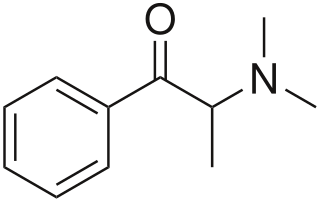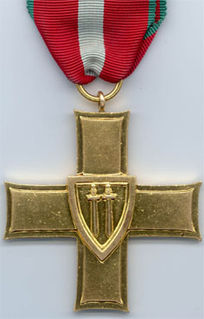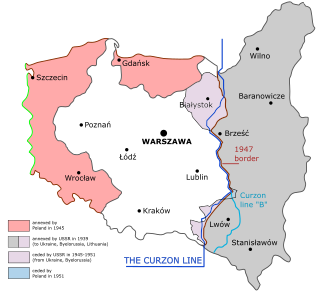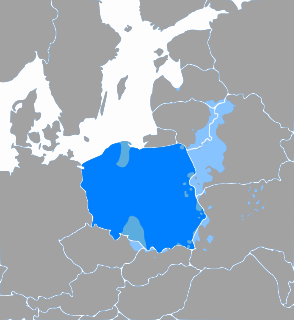
The flag of Poland consists of two horizontal stripes of equal width, the upper one white and the lower one red. The two colors are defined in the Polish constitution as the national colors. A variant of the flag with the national coat of arms in the middle of the white stripe is legally reserved for official use abroad and at sea. A similar flag with the addition of a swallow-tail is used as the naval ensign of Poland.

Leszno Voivodeship was a unit of administrative division and local government in Poland from 1975 to 1998, superseded by Greater Poland Voivodeship. Its capital city was Leszno.
Poland does not legally recognize same-sex unions, either in the form of marriage or civil unions. In 2012, the Supreme Court ruled that same-sex couples have limited legal rights in regards to the tenancy of a shared household. A few laws also guarantee certain limited rights for unmarried couples, including couples of the same sex. Same-sex spouses also have access to residency rights under EU law.

Metamfepramone is a stimulant drug of the phenethylamine, and cathinone chemical classes. Dimethylcathinone was evaluated as an appetite suppressant and for the treatment of hypotension, but was never widely marketed.

The Constitution of the Polish People's Republic was passed on 22 July 1952. Created by the Polish communists in the Polish People's Republic, it was based on the 1936 Soviet Constitution, and it superseded the post-war provisional Small Constitution of 1947 which, in its turn, had declared null and void the pre-war April Constitution of Poland passed by the Polish Sejm in 1935. The Russian text of the Constitution was reviewed and 'corrected' by Joseph Stalin himself, and later translated into Polish. It legalized the communist legislature and practices as they had been introduced to Poland with the Polish Committee of National Liberation in the wake of Red Army progress in 1944.
Krzysztof Władysław Czarnecki is a Polish politician. He was elected to the Sejm on September 25, 2005 getting 3406 votes in 38 Piła district, candidating from the Law and Justice list.

The Order of the Cross of Grunwald was a military decoration created in Poland in November 1943 by the High Command of Gwardia Ludowa, a World War II Polish resistance movement organised by the Polish Workers Party. On 20 February 1944 it was confirmed by the State National Council and on 22 December by the Polish Committee of National Liberation and further confirmed on 17 February 1960 by the government of the People's Republic of Poland.

The 'Borders of Poland are 3511 or 3582 kilometers long. The neighboring countries are Germany to the west, the Czech Republic and Slovakia to the south, Ukraine and Belarus to the east, and Lithuania and the Russian province of Kaliningrad Oblast to the northeast. To the north, Poland is bordered by the Baltic Sea.

JWH-081 is an analgesic chemical from the naphthoylindole family, which acts as a cannabinoid agonist at both the CB1 and CB2 receptors. With a Ki of 1.2nM it is fairly selective for the CB1 subtype, its affinity at this subtype approximately 10x the affinity at CB2. It was discovered by and named after Dr. John W. Huffman.
Koszelewki is a village in the administrative district of Gmina Rybno, within Działdowo County, Warmian-Masurian Voivodeship, in northern Poland. Between 1975-1998, the town was administratively part of the Ciechanów province.

Flephedrone, also known as 4-fluoromethcathinone (4-FMC), is a stimulant drug of the cathinone chemical class that has been sold online as a designer drug starting in 2008.

3,4-Methylenedioxyphenethylamine, also known as homopiperonylamine, is a substituted phenethylamine formed by adding a methylenedioxy group to phenethylamine. It is structurally similar to MDA, but without the methyl group at the alpha position.

JWH-007 is an analgesic chemical from the naphthoylindole family, which acts as a cannabinoid agonist at both the CB1 and CB2 receptors. It was the most active of the first group of N-alkyl naphoylindoles discovered by the team led by John W Huffman, several years after the family was initially described with the discovery of the N-morpholinylethyl compounds pravadoline (WIN 48,098), WIN 55,225 (JWH-200) and WIN 55,212-2 by the Sterling Winthrop group. Several other N-alkyl substituents were found to be active by Huffman's team including the n-butyl, n-hexyl, 2-heptyl and cyclohexylethyl groups, but it was subsequently determined that the 2-methyl group on the indole ring is not required for CB1 binding, and tends to increase affinity for CB2 instead. Consequently, the 2-desmethyl derivative of JWH-007, JWH-018 has slightly higher binding affinity for CB1, with an optimum binding of 9.00nM at CB1 and 2.94nM at CB2, and JWH-007 displayed optimum binding of 9.50nM at CB1 and 2.94nM at CB2.
Gromada Tursko Wielkie is a group consisting of several villages, constituted the lowest tier of local government, taking over the role previously played by gmina Tursko Wielkie; at a smaller scale. In communist Poland between 29 September 1954 and 31 December 1972, this assembly was introduced. Gromada was the lowest administrative division of Poland.
Gromada Osiek is a group of several Polish villages, constituted at the lowest tier of local government. They take over the role previously played by Gmina Osiek at a smaller scale than Gmina Osiek. In communist Poland between September 29, 1954 to December 31, 1972 these villages were introduced as a Polish word meaning “Osiek”. These units are created by the Communist Polish Law and have legal effect.

The Bug River property is property which was within the territory of the interbellum Poland and was abandoned by Polish owners after 1945. it was abandoned when the territory was no longer inside of Poland. The name refers to Bug River because the Bug is a major part of the new eastern boundary of Poland, separating the so-called Eastern Borderlands from the rest of the former Polish territory. The Bug River property is located within the states of Belarus, Lithuania, and Ukraine. The claims for compensation for this lost property are known as the Bug River claims.

Polish National Flag Day - Polish holiday introduced by the act issued on the 20 February 2004. The holiday is celebrated on the day between two national holidays: 1 May and 3rd of May
The Act on the Institute of National Remembrance – Commission for the Prosecution of Crimes against the Polish Nation is a 1998 Polish law that created the Institute of National Remembrance. This memory law was amended twice, in 2007 and 2018.













